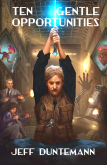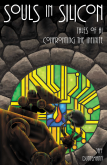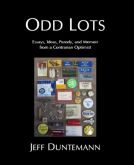- Here’s another hyperenergetic instrumental piece—with a short rest in the middle, granted—from Joseph Curiale, he of “Sky Blue After Rain.” It’s called “Double Happiness,” and it’s nutso optimistic, kinda like…me.
- Speaking of music, I remain and have always been puzzled why the purely orchestral works of Leroy Anderson are not considered “classical” and are not played on classical stations like our KBAQ. Some are quirky, like “The Typewriter,” but my all-time favorite Anderson composition, “Bugler’s Holiday,” which is really a manic trumpet concerto, somehow doesn’t qualify. Too fast? Hey, if “Sabre Dance” is considered classical, why not “Bugler’s Holiday”?
- Video generative AI is evidently getting so good that people are making bank–big bank–on slop AI videos, some that can’t easily be told from real videos. It’s more than a little scary. I don’t either make or consume video as a rule, but I would be interested in seeing a verifiably AI-written SF novel.
- Here’s another piece that nails why I think generative AI is scary. Watermarks? If an AI can make photorealistic videos, it can fake a watermark. Maybe something incorporating blockchain as is done with NFTs. I’m no expert on blockchain, but this intro to blockchain and NFTs sounds like it’s impossible to replicate an NFT—which suggests a way to prove that a video was not done with AI.
- In case you missed it: Lazarus 4.2 (Built with Free Pascal 3.2.2) was released on July 22. It’s a bugfix release, but hey, bugs are annoying and Lazarus is amazing. Take every release that happens and install it.
- I grew up in Illinois and have always been at least a little interested in monsters, so why did it take 73 years for me to ever hear of the Enfield Monster? Sure, Enfield is at the opposite end of Illinois from Chicago, a long way from anywhere, with all of 794 inhabitants—and only 764 when the monster came calling in 1973. I guess without Internet, even for an eccentric and boundlessly curious 21-year-old, some things just come and go unnoticed. By me, at least. It makes me wonder what other monsters I’ve never heard of.
- Ars Technica points out that it generally takes a garage with a high-current 240VAC outlet to charge an EV at home. And—wow, how could this be possible?—a great many Americans have garages so full of stuff that they have to park their cars outside. Yes, it’s possible; actually, the honest truth, as we see every time we drive around our neighborhood.
music
Odd Lots
Odd Lots
- It’s a little late but there’s still time to see it: Tonight will be the full Moon, and also a partial lunar eclipse. 7:45 PM makes it about ideal for the Pacific and Arizona time zone, with all the usual adjustments for Mountain, Central and Eastern.
- Scott Pinsker posted an article on PJMedia back on September 9th, about dogs allowing humans to out-compete Neanderthals. I wrote about that back in 2010: Dogs were alarm systems that made dawn raids ineffective. Lacking dogs, Neanderthals may have simply dawn-raided themselves into extinction.
- I’m looking for a book that defines terms and instruments used in classical music. Andante, allegro non troppo, adagio, the viola, the celesta, and that instrument consisting of a series of pieces of metal tubing hung from strings under a bar, whose name I just cannot recall. A lot of that stuff can be found online, but, well, I’m just partial to books. If you have one that you like, please mention it in a comment.
- The blinking cursor on our computer screens is now 54 years old. Here’s a short history of how it came about.
- It’s been a pretty sparse hurricane season, with the single exception of Beryl. Right now on NOAA’s hurricane map there is a dying hurricane in Arkansas, one named tropical storm, Gordon, and two disturbances with less than 40% chance of becoming cyclonic. We’re halfway through hurricane season, and not much has been happening. My take: predicting a hurricane season’s severity is a fool’s model. Too much chaos and butterfly effect. It could get worse any time. Or it might not. We won’t know until we get there.
- Who had this on their 2024 bingo cards? Good ‘ol Yellow #5 dye, in large quantities, makes living tissue temporarily transparent. Scientists have created temporarily transparent mice. No human trials have happened as yet. So go easy on those Cheetos, ok?
- This is boggling but perhaps inevitable, assuming it’s true—and I’m skeptical: A chemhacker group is creating software and desktop labware allowing people to synthesize expensive prescription medications at home. An $800 pill becomes a $1 pill. Yes, there are risks, but if you’re dying for lack of an expensive drug, well…
- Over on City Journal Michael Totten has a long-form meditation on Liu Cixin’s SF trilogy Remembrance of Earth’s Past that bears on the Fermi Paradox and the question of whether we should actively seek out alien life–or hide from it. A little outside what I see in City Journal, but well-worth reading.
Odd Lots
- Alas, we have lost my favorite country music star, Toby Keith, of stomach cancer, at 62. He had lots of hits, but may be most famous for “Should’ve Been a Cowboy,” the most-played country song of the 1990s. (And if you’ve never seen my filk “Should’ve Been a Jedi,” you can find it here.) Eternal rest grant unto him, O Lord, and let perpetual light shine upon him.
- Ever heard of Venus’ moon Zoozve? You say Venus doesn’t have any moons? Well…it’s complicated. And interesting. Not to mention funny as hell.
- Orkin (the bug people) posted a list of the top 50 US cities for bedbug infestations. My home town is #1. My current metro isn’t even on the list. I guess I chose wisely.
- February is National Grapefruit Month, and today is National Fettuccine Alfredo day. Alas, my birthday is National Mud Day—granting that when I was a kid, I played happily in the mud. How do I know such important things? Of course: There’s a website for it. Select a day, week, or month, and who knows what people will be celebrating?
- Well, it’s not exactly a flying car, but…it’ll do, it’ll do.
- Three million malware-infected smart toothbrushes were gathered into a botnet that tormented Swiss servers with DDOS attacks. Uggh. My toothbrush is smart enough to be dumb. And hey, it smells like Pepsodent. Can’t beat that!
- Trout gonads can cure baldness when injected into your head. So just eating the trout doesn’t work? Bummer. I’m out.
Spiking a Christmas Song
I was going to mess with an ancient Christmas song involving eating pig heads—surely you’ve heard of “The Boar’s Head Carol”—but that may have to wait for another day, ideally after everybody’s already had Christmas dinner.
No, this morning I want to write about something I learned just yesterday, about another Christmas song that Carol and I both like. We’ve never heard it on the radio, and we wouldn’t know about it at all if it weren’t on our very favorite Christmas CD: Christmas Portrait by the Carpenters (1978). The song is the medley “It’s Christmas Time/Sleep Well, Little Children.” It’s on none of our other numerous Christmas CDs, and my assumption has long been that Karen and Richard wrote it themselves, as it’s a little bit whimsical and in spots a little bit goofy.
I got curious yesterday and looked it up. The song was actually written by four men: Alan Bergman, Al Stillman, Victor Young, and Leon Klatzkin. It’s not new; in fact, it was first recorded in 1953. And when I read who first recorded it, I laughed out loud. It was Spike Jones!
Ok, I suspect young people will wonder who that is, and why his name made me laugh. Short form: Spike Jones (1911-1965) was the Weird Al Yankovic of the 1940s and 1950s. He took popular songs of other artists and recorded them in his own satirical style, with manic voices, gunshots, whistles, cowbells, hiccups, and other “special effects”. I came upon Spike Jones and His City Slickers when I was quite young; probably five or at most six. In that era my folks had a creaky old record player and a cabinet full of 78RPM records, including a few by Spike. His best known spoof song is probably “Cocktails for Two.” Note that the linked YouTube item is not a video of Spike and his band performing the song. It’s a sort of primordial music video, with Spike playing a bartender with many of the sound effects done by tipsy men at the bar. I’m sure sophisticates will roll their eyes, but when I was six I thought the song was hilarious.
So when I went looking for Spike’s version of “It’s Christmas Time” on YouTube, what I found is a cut from Spike’s Christmas album—and on this cut at least, Spike himself is notably absent. The song is played straight, with no silly sound effects, but rather a nice choir and lots of harmony. I imagine it’s Spike’s City Slickers band playing in the background. There’s a little bit of goofiness in some of the other cuts from that album, but for the most part it’s just Fifties Big Band vocals playing Christmas standards. Several are on YouTube; listen to a few if you’re interested.
I have to wonder what Spike thought of rock and roll, and what he might have done with it (or to it, more likely) had he not smoked himself to death at 53. He wasn’t a filker (like Bob Rivers of Twisted Christmas) and I wonder if he had imitators. If he did, I’ve never heard of them.
In the meantime, thanks to all of you for reading me in whatever form, and putting up with my occasional Spike Jones-ish metaphors like the Base Four Martians in my assembly language book. Have a fun Christmas, with good food, good wine, good friends, good music (even if it’s a little goofy in spots) and an occasional glance to the heavens, and a word of thanks to God, who gave us the ability to laugh and be silly as we make our way through His beautiful and extravagant creation!
Found it! (No Thanks to “Query By Humming”)
Well, after supper this evening I finally found a piece of music I had been searching for since, well, I’m not entirely sure. But waaaaaay back when I was in third or fourth grade (think 1961-62) my Catholic grade school did a kind of a talent show, mostly by seventh and eighth graders. There was singing and dancing and music of various sorts, but one composition threw me back in my chair. Everything I liked and still like in music was there: melody, harmony, energy. The music was from a record (it was an instrumental) and what may have been an eighth-grade girl in a sequined costume did a dance routine that included baton twirling. (Add “baton twirling” to my list of things that are disappearing or are already gone.) I was impressed by her ability to dance and twirl at the same time, but the song—it has remained vivid in my memory to this day.
I can whistle it—and have whistled it for several people, in hope that they could name it. The name of the song was on the mimeographed show program that we all received, but as vivid as the song itself has remained, its name vanished into the mists of my personal history. I get the sense for a title like “Trumpet Jubilee” but no such song (as best I can tell) exists.
“Query-by-humming” is a term I first heard from David Stafford, and Google can actually do that—sorta. If I’m in a store and their Muzak channel is playing something that appeals to me, I yank out my phone, bring up Google, and hit the microsphone icon. The problem with Google is that it can only identify recorded music. I tried whistling the song into Google any number of times, but it always threw up its hands and gave up.
So this evening over dinner it occurred to me out of nowhere: That song sounds like something Leroy Anderson would do. So once we got the dishes done, I ran back in here to my office and looked for a list of Anderson compositions. No “Trumpet Jubilee.” But…”Bugler’s Holiday?” Dare I hope? I went to YouTube and found a recording by the US Army Band.
YESSSSS! That’s it!
There are a dozen performances on YouTube, all of them very listenable. One thing I found peculiar is that every single one of them seems faster than I recall the rendition played for that baton-twirling eighth grader in 1962. Maybe I hear it more slowly in my head because I can’t whistle anywhere near that fast.
Who cares! I found it!
(I’ve already scolded myself for grumbling that those are trumpets, not bugles.)
So. Look for something long enough, and sooner or later you’ll find it. In 1968 I heard a no-hit-wonder band play the Monkees song “Shades of Gray” exactly once…with a faint recall that the band was The Willoughbys. It took 35 years, but I eventually found it in a book listing rock 45s, only the band was The Will-O-Bees. I mentioned it here on Contra and actually got an email from Janet Blossom, their lead singer. I bought that 45 at a crufty used record store, ripped it and cleaned it up, and now I can play it whenever I want.
I’ll do the same with “Bugler’s Holiday.” Except now I’ll just go up to Amazon and buy the MP3. No ripping required.
Having scored this victory, I’ll now dredge the swamp in my brain to see what else in the line of music I might have forgotten that would be well worth listening to.
Flashback: New Music on YouTube
I posted this entry last year on 12/23. I haven’t discovered a lot of new Christmas music since then, so I’ll repost the entry here in its entirety. This may become an annual thing, plus new tracks as I discover them. So earbuds on and enjoy!
As we close in on Christmas, I wanted to post a few items I’d found and liked on YouTube. Nearly all of it is Christmas music. (I’ll post some other non-Christmas discoveries in a future entry.)
- First up is a kid choir, this one assembled by the Trans-Siberian Orchestra, to provide words to Pachelbel’s Canon in G. Until relatively recently I thought the TSO was a Russian group. Not so; they’re from Florida. My only complaint is that I can’t make out the words except here and there. Not to sweat; my friend William Meyer found them.
- I was startled when I clicked on a YouTube-suggested track, “God Rest Ye Merry, Gentlemen” by Geoff Castellucci. Not sure if you remember Tennessee Ernie Ford. I do. Ford was a bass, but this guy Geoff is a bass so deep he brushes the Earth’s mantle. Yet he does the same trick that Peter Hollens does, and harmonizes with himself with four video images, all singing at once. Range? He’s got it, lordy.
- For comparison, here’s the good Mr. Ford doing his cover of the same song.
- My really big discovery in 2021was Pentatonix, a marvelous a capella group. How did I get to be this old without ever hearing about them? Their cover of “God Rest Ye Merry, Gentlemen” is dazzling. (Bet you can’t guess what my favorite Christmas song is, heh.)
- I do have other favorites, and the Wayne Gratz cover of “It Came Upon a Midnight Clear” is right up there. This isn’t new; I’ve had it on CD for many years. I just wanted you to hear it, and it’s free on YouTube.
- More Pentatonix, from the live action How the Grinch Stole Christmas. I’d love to hear the bass who sang “You’re a Mean One, Mr. Grinch” in the original 1966 cartoon do a cover. Geoff Castelluci could do it, since the marvelously gravelly Thurl Ravenscroft is no longer with us.
- And still more Pentatonix: The lyrics of “White Winter Hymnal” don’t make any sense, but the harmony is good and the video is actually a lot of fun to watch.
- I’d heard this one before, but it’s been awhile, the John Williams theme to that over-the-top Christmas movie Home Alone . My mother used to make gingerbread houses, lots of them, almost every year, and gave most of them away. I remember that gingerbread feeling well, and will forever and ever, amen. Nobody did gingerbread houses like Victoria Albina Duntemann.
- It’s not quite a Christmas song, but it’s a hymn that should get more play than it does. There are lots of covers on YouTube. This is currently my favorite, but I doubt I’ve heard even a tenth of them.
- This one was brand-new to me: “Christmas Rush” by composer Matthew Curtis. It’s unusual in that it’s a completely new orchestral composition that doesn’t incorporate familiar Christmas melodies like a lot of orchestral Christmas music. But it’s upbeat, happy, and energetic without getting too manic. (Not that there’s anything wrong with manic now and then; see below.)
- Last year I happened to hear the orchestral piece “A Christmas Fanfare” from the BYU Philharmonic Orchestra on KBAQ and immediately bought the MP3 on Amazon. Weirdly, I do not see it on YouTube, even though the orchestra is very well-represented there. So what I can give you is the Amazon link. It’s a fine piece blending a number of Christmas favorites into a single polished work. 99c. Get it.
- I’ll wrap up here with yet another piece of orchestral Christmas music that captures a lot of my goofy, upbeat, borderline-manic hyperpollyannic spirit, of which a college colleague once said, “The trouble with you, Jeff, is that you’re too damned happy!” Well, yeah. Weave together a bunch of my favorite Christmas melodies into a brilliantly orchestrated march with energy exploding out of every treble clef, and my patron’s saint’s affirmation rises up in blinding light: All will be well. And all will be well. And all manner of thing will be well!
And that, my friends, is precisely what Christmas music is for.
Odd Lots
- KBAQ, our local classical radio station here in Phoenix, is going to be playing Halloween-ish classical music this evening, from 7 to 10PM Pacific time. You don’t have to be in Phoenix to hear it; the station can be streamed for free by clicking on the Listen Live button from your Web browser.
- The hard outer coating of candy corn is made from the same stuff as the old (and now uncommon) wood finish, shellac. I.e., the lac bug, which produces a resin that can be turned into a hard coating. I used to use a lot of shellac on my home-made bookshelves. I always wondered howthehell many bugs it took to make a quart of shellac. As for lac resin in candy corn:, it can’t be too toxic, or I wouldn’t still be here.
- From the Speaking Of That Department: When I was six, my Grandma Sade gave me a Pez dispenser and a little thing of Pez candies. When I ran out of Pez, I tried putting candy corn (which we had a bag of at home) into the dispenser. The dispenser broke, to my severe annoyance. The upside is that I took it apart and discovered how it worked. That said, I’m not entirely sure I ever had another Pez dispenser.
- M&Ms are popular with astronauts, so much so that the little spheroids are on the International Space Station menu. I’ll bet the same isn’t true of candy corn.
- Stratolaunch is having excellent results with their Roc carrier plane, which is currently the largest airplane in the world. It’s basically two aircraft joined beneath a single looooooong wing, from which Stratolaunch will test-fly hypersonic aircraft. More video here, with a better view of the Roc.
- Dayum. China has developed a drone that can drop robot dogs equipped with machine guns. This very gizmo was a plot point in my unfinished novel The Molten Flesh. There was also a drone with a lethal laser, but having protagonist Ron Uhlein jump on the back of a robodog gun made for a much livelier action scene.
- Under Elon Musk’s ownership, Twitter is about to start charging bluechecks $20/month for their blue checks. My guess is that Twitter will thereafter have a lot fewer bluechecks.
- The bluecheck program has been tacky since the platform’s creation, arbitrarily separating a wholly artificial elite from the masses. If Musk changes this to provide a bluecheck to anyone presenting verification credentials and $20, the blue check will still be useful, but it will no longer confer prestige. Real prestige takes years of effort to learn. This kind of fake prestige should be the first thing to go.
- Where will the hyperventilating anti-Musk crowd go? Could to be Twitter founder Jack Dorsey’s Bluesky, a decentralized network of networks held together by federation. I wrote about Bluesky at some length in yesterday’s Contra entry, which would be a good starting point if you’re interested.
- My guess is that Bluesky is roughly comparable to Mastodon, a federated social network that’s been around for some time. More is on Wikipedia. It sounds good–I like decentralization–but I find it remarkable how little there is about it online.
- For the first time in US history, there will be a total eclipse of the Moon on election day, November 8 of this year. They’re calling it the Blood Moon, which has a really creepy vibe to it, considering the current chaotic state of our political gestalt, On the other hand, today is Halloween, and creepy vibes are all over the place.
Odd Lots
- Here’s a longish research paper from the NIH National Library of Medicine exploring studies of the effects of light at night (LAN) on various body functions. One of the most startling is the degree to which night work correlates to obesity and Type II diabetes. Less clear but more concerning are links between LAN and certain cancers. The message appears to be: Sleep at night, in the dark. Carol and I do that, and have all our lives.
- Hating the Other evidently heightens activity in our reward centers. The late Colin Wilson explored the issue, and claimed that in modern society we have to give ourselves permission to hate the Other…but once we do, hating the Other is delicious and hard to stop. This explains a lot about tribalism in modern politics, 90% of which is about hating the Other–and an important reason why I don’t write about politics.
- Virginia Postrel has a related article on her Substack, about the role of what she calls “purity” and its relation to cancel culture. She mentions Gavin Haynes’ notion of a “purity spiral,” which I think nails the whole purity business. It’s an effort to outbid others in pursuit of an unattainable ideal. It is thus more evidence supporting my notion that idealism is evil.
- I’ve always wondered why music in a minor key sounds sad, spooky, or creepy. Here’s one of the better online essays on the subject.
- I include this (slightly) related item because it asks a question I’ve never heard asked before: What is the most evil chord in music? I would guess it’s the chord that runs around with a chainsaw, cutting treble clefs in thirds, and playing hob in a minor key.
- I wonder how I got to be 70 without ever hearing about raccoon dogs, which are neither raccoons nor dogs. They’re an interesting, albeit invasive, species of canid found in the Far East. The Japanese call them Tanuki, though I don’t recall them coming up in conversation when I was in Japan in 1981.
- Speaking of my 70th birthday, my writer friend and collaborator Jim Strickland brought a Cabernet Sauvignon to our dual birthday party on July 16. I tried it and found it…not bitter. That was a first in my wine experience, granting that once I tasted a few bitter specimens, I basically stopped trying them. The wine in question is from Daou, vintage 2020. About $20 at our Kroger-affiliate supermarket. Quite dry, but no oak, which spoils all the other flavors for me..
- Well. Ever heard “Bohemian Rhapsody” played on several disemboweled scanners and piles of 5″ floppy drives, plus the occasional phone modem? Here’s your chance.
- In case you don’t yet have enough interesting things to read, here’s the Smithsonian’s history of the hard hat.
- Back in June, people in San Francisco reported that anchovies were falling from the sky. People did not report anyone running around the city’s streets holding a pizza and hoping for free fish.
- Hey, this was evidently a banner year for Pacific Coast anchovies. My guess is that with no one putting them on pizzas anymore, their depleted populations have rebounded.
- After using it since 2005, LiveJournal has canceled my account there. I don’t think anybody was reading it anyway. It was a mirror, and I have better backup schemes now.
New Music on YouTube
Way back in the summer I posted here about digging around on YouTube for new music, particularly in the realms of melody and harmony. I admit that an occasional hard rock song appeals to me for reasons unclear, a good example being the Gin Blossoms’ “Found Out About You.” The human brain is a weird business, but we’re all nerds here and you knew that.
So, as we close in on Christmas, I wanted to post a few items I’d found and liked on YouTube. Nearly all of it is Christmas music. (I’ll post some other non-Christmas discoveries in a future entry.)
- First up is another kid choir, this one assembled by the Trans-Siberian Orchestra, to provide words to Pachelbel’s Canon in G. Until relatively recently I thought the TSO was a Russian group. Not so; they’re from Florida. My only complaint is that I can’t make out the words except here and there, and the video is old enough (2009) that there are no subtitles.
- I was startled when I clicked on a YouTube-suggested track, “God Rest Ye Merry, Gentlemen” by Geoff Castellucci. Not sure if you remember Tennessee Ernie Ford. I do. Ford was a bass, but this guy Geoff is a bass so deep he brushes the Earth’s mantle. Yet he does the same trick that Peter Hollens does, and harmonizes with himself with four video images, all singing at once. Range? He’s got it, lordy.
- For comparison, here’s the good Mr. Ford doing his cover of the same song.
- My really big discovery this year was Pentatonix, a marvelous a capella group. How did I get to be this old without ever hearing about them? Their cover of “God Rest Ye Merry, Gentlemen” is dazzling. (Bet you can’t guess what my favorite Christmas song is, heh.)
- I do have other favorites, and the Wayne Gratz cover of “It Came Upon a Midnight Clear” is right up there. This isn’t new; I’ve had it on CD for many years. I just wanted you to hear it, and it’s free on YouTube.
- More Pentatonix, from the live action How the Grinch Stole Christmas. I’d love to hear the bass who sang “You’re a Mean One, Mr. Grinch” in the original 1966 cartoon do a cover. Geoff Castelluci could do it, since the marvelously gravelly Thurl Ravenscroft is no longer with us.
- And still more Pentatonix: The lyrics of “White Winter Hymnal” don’t make any sense, but the harmony is good and the video is actually a lot of fun to watch.
- I’d heard this one before, but it’s been awhile, the John Williams theme to that over-the-top Christmas movie Home Alone . My mother used to make gingerbread houses, lots of them, almost every year, and gave most of them away. I remember that gingerbread feeling well, and will forever and ever, amen. Nobody did gingerbread houses like Victoria Albina Duntemann.
- It’s not quite a Christmas song, but it’s a hymn that should get more play than it does. There are lots of covers on YouTube. This is currently my favorite, but I doubt I’ve heard even a tenth of them.
- This one is brand-new to me: “Christmas Rush” by composer Matthew Curtis. It’s unusual in that it’s a completely new orchestral composition that doesn’t incorporate familiar Christmas melodies like a lot of orchestral Christmas music. But it’s upbeat, happy, and energetic without getting too manic. (Not that there’s anything wrong with manic now and then; see below.)
- Last year I happened to hear the orchestral piece “A Christmas Fanfare” from the BYU Philharmonic Orchestra on KBAQ and immediately bought the MP3 on Amazon. Weirdly, I do not see it on YouTube, even though the orchestra is very well-represented there. So what I can give you is the Amazon link. It’s a fine piece blending a number of Christmas favorites into a single polished work. 99c. Get it.
- I’ll wrap up here with yet another piece of orchestral Christmas music that captures a lot of my goofy, upbeat, borderline-manic hyperpollyannic spirit, of which a college colleague once said, “The trouble with you, Jeff, is that you’re too damned happy!” Well, yeah. Weave together a bunch of my favorite Christmas melodies into a brilliantly orchestrated march with energy exploding out of every treble clef, and my patron’s saint’s affirmation rises up in blinding light: All will be well. And all will be well. And all manner of thing will be well!
And that, my friends, is precisely what Christmas music is for.
Hallowander
Halloween. Wow. It seemed like the Fourth of July was just a few weeks ago. Then Carol and I walked into Wal-Mart. We live on a street with only a few kids, and if memory serves we ended up eating most of last year’s candy ourselves. So we bought a couple of bags of stuff we wouldn’t mind finishing, if it comes to that.
And it will.
At Wal-Mart (and probably almost everywhere else in the retail universe) Halloween was already over, and shoved to one side of the Seasonal aisle. Many of the candy SKUs were gone, including every species of M&Ms but…popcorn. Huh? Popcorn flavored M&Ms? I’d like to say I’ve seen stranger things, but I’m not sure I can. (Ok, sure: Peanut butter-flavored whiskey is a contender, as is coffee-flavored Coke.) At least we got it cheap. And the rest of the Seasonal aisle–along with much of the rest of the store–was already full-bore Christmas. No surprise.
And still tiny radishes. That’s the only kind of radishes you can get at Wal-Mart. Back in September you could still get full-sized radishes at Fry’s and Safeway. Now everybody is selling miniature radishes. I like slicing radishes and covering the tops of our salads with them. Microradishes cut a little easier than big radishes, but you have to cut a whole lot more of them.
Oh–and Total Wine now sells a red blend infused with…habanero. Maybe there’s a habanero surplus because everybody with asbestos esophagi are demanding ghost peppers in everything. So the winemakers could be getting them cheap. (An aside: Witching Hour wines are decent, for cheap red blends. Why not get a bottle for your Halloween festivities? There are several SKUs. Just read the labels before you drop them in your shopping cart, ok?)
Maybe there’s a habanero surplus. I really don’t care, as long as they don’t start loading it into iced coffee. But I will tell you something else: There is a severe onion-ring shortage. Two fast-food restaurants that we haunt now and then haven’t been able to get onion rings for literally weeks. For Corleone’s, it’s been longer than that. A little sniffing around online tells me that the world’s #1 exporter of onions is…China. So the nation’s onion rings are likely as not sitting in that immense barge-clot that’s jamming up California ports, especially off Los Angeles.
There’s hope on that front. As usual, the problem devolves to idiotic regulation by government seat-warmers who’ll gladly collapse the world’s economy because a handful of whiners in LA complains that they can see containers stacked more than two high at the ports. If they’re on a ladder. And holding binoculars. Here’s a long-form explanation of how that was discovered and how it was (maybe, or might be) solved. Let us pray. I miss onion rings.
My old friend Mike Bentley posted a link to a stack rank of books about…drumroll please…the PowerPC CPU. My PowerPC book came in at #7. Mike’s was at #24. All those books were long ago and far away. Once Apple switched to Intel CPUs, the PowerPC went gently into that good night. That’s too bad; it was a solid architecture and deserved better. In case you’re interested in PowerPC books, you can get mine on Amazon. It’s a shame the mass-market paperback is now going for $877.95. I guess you’d better order the trade paperback, which sells for $4.75. A footnote: There never was a mass-market paperback edition. Maybe it’s a ghost. (More likely a daemon, heh.)
Carol has a recipe for beer bread that she wants to try, and we’re going to make it pumpkin-spice beer bread. How? By using pumpkin-spice beer. I bought a 12 oz can of Sleepy Dog Gourdgeous Pumpkin Spice Ale yesterday. You likely won’t see it in stores because it’s a local product, produced in Tempe, a suburb of Phoenix. Not sure how well it will work. I’ll let you know.

A quick aside: I’m still getting old coins in change at McDonald’s and other stores when I pay cash. The nation’s penny jars are still emptying into our outstretched hands. The other day I scored a 1969-S and a 1975-D in one transaction.
Speaking of stack-ranks, Google has a search-trends stack rank of Halloween costumes. We don’t see a lot of kids in costumes anymore, and it’s been a very long time since I wore one myself. I’m thinking a lot of these popular outfits are popular with adults. #1 is Witch. (My psychic powers predicted that one.) It’s an interesting list, and starts getting peculiar fairly quickly. #10 is Chucky, the serial murderer doll from the Chilld’s Play flicks. #18 is the 1980s. Ok, I could see the 1970s as a costume. (Maybe I wore a costume more recently than I thought.) But the ’80s? What is it? A pinstriped suit with matching vest? It surprised me that Princess was down to #30. Disney may have saturated its market. I had to look up “The Purge,” which took #38. And #49: The 1990s? I got nuthin’. (The site does not provide examples, just stats.) Oh–#59 was the 1970s. Dressing a kid up like the 1970s might be considered child abuse in some jurisdictions. And that’s as far as I went.
KBAQ, our local classical music station, is going to be playing Halloween-appropriate classical compositions all day long and into the evening, including a lot you may not have heard of. You can stream it here no matter where you live. If you like classical music, it may surprise you how many compositions are about ghosts, devils, death, and wizardry/witchery–or at very least sound like they should be. (One example is the waltz from Aram Khachaturian’s Masquerade.)
In closing, on this long afternoon of the creepiest night of the year, I present a recent translation of an ancient Halloween prayer that most of you have heard many times:
“From goosies and goalies and long-legged besties
And things that grow hemp in the night,
Good Lord, deliver us!”











